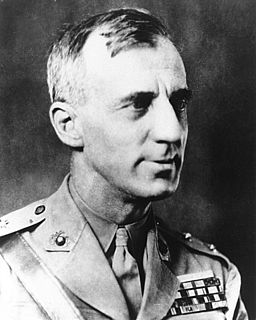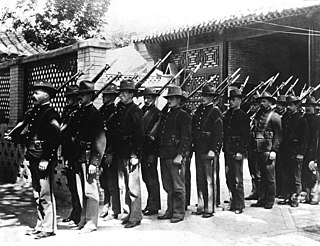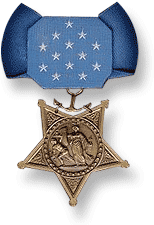 W
WRear Admiral Reginald Rowan Belknap was an officer in the United States Navy. He served in the Spanish–American War, Boxer Rebellion, Philippine–American War, and World War I. He gained distinction in 1909 for his relief work in Italy after the 1908 Messina earthquake and tsunami and for his work in command of the first offensive mining campaign in U.S. Navy history, the laying of the North Sea Mine Barrage in 1918. He was also a published author, an inventor, a member of many professional and social organizations, and an active member of the Episcopal Church, and he played a role in the selection of Amelia Earhart as the first female pilot to make a solo flight across the Atlantic Ocean.
 W
WMajor General William Phillips Biddle was the 11th Commandant of the United States Marine Corps.
 W
WAndre Walker Brewster was a career officer in the United States Army He attained the rank of major general and served in several high-profile assignments, including Inspector General of the United States Army and Inspector General of the American Expeditionary Forces during World War I. In addition to his World War I service, Brewster was a veteran of the American Indian Wars, Spanish–American War, Philippine Insurrection, and Boxer Rebellion. He received the Medal of Honor for his role in the Boxer Rebellion's Battle of Tientsin.
 W
WMajor General Smedley Darlington Butler, nicknamed "Old Gimlet Eye", was a senior United States Marine Corps officer who fought in the Philippine–American War, the Boxer Rebellion, the Mexican Revolution and World War I. During his 34-year career as a Marine, he participated in military actions in the Philippines, China, and Central America; the Caribbean during the Banana Wars; and France in World War I. Butler was, at the time of his death, the most decorated Marine in U.S. history. By the end of his career, Butler had received 16 medals, five for heroism. He is one of 19 men to receive the Medal of Honor twice, one of three to be awarded both the Marine Corps Brevet Medal and the Medal of Honor, and the only Marine to be awarded the Brevet Medal and two Medals of Honor, all for separate actions.
 W
WSir Donald Charles Cameron, was an Australian politician and soldier. He was a member of the Australian House of Representatives as the Nationalist Party of Australia member for Brisbane from 1919 to 1931 and as the United Australia Party member for Lilley from 1934 to 1937.
 W
WAdna Romanza Chaffee was a lieutenant general in the United States Army. Chaffee took part in the American Civil War and Indian Wars, played a key role in the Spanish–American War, and fought in the Boxer Rebellion in China. He was the Chief of Staff of the United States Army from 1904 to 1906, overseeing far-reaching transformation of organization and doctrine in the army.
 W
WThe term China Marines, originally referred to the United States Marines of the 4th Marine Regiment, who were stationed in Shanghai, China from 1927 to 1941 to protect American citizens and their property in the Shanghai International Settlement, during the Chinese Revolution and the Second Sino-Japanese War. Those Marines stationed at the embassy in Peking and the consulate in Tientsin referred to themselves as North China Marines.
 W
WRobert Sterling Clark, an heir to the Singer Sewing Machine fortune, was an American art collector, horse breeder, and philanthropist.
 W
WArthur Latham Conger Jr. was an officer in the United States Army and an author and editor. A veteran of the Spanish–American War, Philippine–American War, Boxer Rebellion, Pancho Villa Expedition, and World War I, he attained the rank of colonel and devised the World War I deception known as the Belfort Ruse. A noted theosophist, he served as president of Theosophical Society Pasadena.
 W
WJohn O. Dahlgren was an American corporal serving in the United States Marine Corps during the Boxer Rebellion who received the Medal of Honor for bravery.
 W
WDaniel Joseph Daly was a United States Marine and one of nineteen men to have received the Medal of Honor twice. All Marine double recipients except Daly and Major General Smedley Butler received both Medals of Honor for the same action.
 W
WWilliam C. Davis was a career officer in the United States Army. A veteran of Spanish–American War, Philippine–American War, Boxer Rebellion, World War I, he attained the rank of major general and was a recipient of the Army Distinguished Service Medal. Davis was most notable for his First World War command of the 31st Heavy Artillery Brigade, 32nd Heavy Artillery Brigade, and the V Corps Artillery.
 W
WRobert Henry Dunlap was a general in the United States Marine Corps.
 W
WSergeant Alexander Joseph Foley was a member of the United States Marine Corps who was awarded the United States' highest military decoration, the Medal of Honor, for having distinguished himself during the Boxer Rebellion.
 W
WCharles Robert Francis was a Marine who received the Medal of Honor for actions on June 21, 1900, near Tientsin, China during the Boxer Rebellion.
 W
WBen Hebard Fuller was a major general in the United States Marine Corps and served as the 15th Commandant of the Marine Corps between 1930 and 1934.
 W
WWilliam Francis Hamberger was an American sailor serving in the United States Navy during Boxer Rebellion who received the Medal of Honor for bravery.
 W
WHans Anton Hansen was an American sailor serving in the United States Navy during Boxer Rebellion who received the Medal of Honor for bravery. The US sailor who is buried at Arlington National Cemetery is not the Medal of Honor recipient and his grave is mismarked.
 W
WWilliam Charlie Horton was a United States Marine and a recipient of the United States military's highest decoration, the Medal of Honor, for his actions during the Boxer Rebellion.
 W
WMartin Hunt was an American Private serving in the United States Marine Corps during the Boxer Rebellion who received the Medal of Honor for bravery.
 W
WCharles Evans Kilbourne Jr. was the first American to earn the United States' three highest military decorations. As an officer in the United States Army he received the Medal of Honor for his actions during the Philippine–American War and he served as a general officer during World War I. After World War I, he served as the Superintendent of the Virginia Military Institute, succeeding General John A. Lejeune, and had a post-military career as a distinguished writer.
 W
WCommodore Dudley Wright Knox was an officer in the United States Navy during the Spanish–American War and World War I. He was also a prominent naval historian, who for many years oversaw the Navy Department's historical office, now named the Naval History and Heritage Command.
 W
WLouis Bowen Lawton was a United States Army officer during the Boxer Rebellion who earned the Medal of Honor for his actions at Tientsin, China on July 13, 1900. An 1893 graduate of West Point, Lawton was a 1st Lieutenant at Tientsin. He was awarded the Medal of Honor on March 11, 1902. He is buried in Auburn, New York.
 W
WFleet Admiral William Daniel Leahy was an American naval officer who served as the senior-most United States military officer on active duty during World War II. He held multiple titles and was at the center of all major military decisions the United States made in World War II.
 W
WAdmiral Richard Henry Leigh was a United States Navy officer who served during the late 19th and early 20th century. His service included active duty in the Spanish–American War, Philippine–American War, American Intervention in China, World War I, as well as numerous smaller actions in South America. His service during World War I led to the further development of hydrophone technology to hunt submarines. Following World War I Leigh rose to the rank of four-star admiral and served as Commander, Battle Force, U.S. Fleet (COMBATFOR) from 1931 to 1932 and as Commander in Chief, U.S. Fleet (CINCUS) from 1932 to 1933.
 W
WColonel Emerson Hamilton Liscum was a U.S. Army officer who fought in the American Civil War, Indian Wars, Spanish–American War, and the Philippine–American War. He was killed in battle at Tianjin, China during the Boxer Rebellion while commanding the 9th Infantry Regiment.
 W
WMajor General Charles Grant Long was the second Assistant Commandant of the Marine Corps. He was also a recipient of the Marine Corps Brevet Medal and Navy Cross.
 W
WRear Admiral Bowman Hendry McCalla was an officer in the United States Navy, who was noted for his roles in the Spanish–American War and putting down the Boxer Rebellion.
 W
WLieutenant Commander John McCloy, USN was an officer in the United States Navy who was one of only 19 individuals to receive the Medal of Honor twice. He received his first Medal of Honor for action in the Boxer Rebellion in June 1900. His second Medal of Honor came in 1915 for action in Vera Cruz, Mexico in April 1914.
The Military Order of the Dragon was an exclusive fraternal order founded in 1900 by members of the China Relief Expedition, a U.S. military force that participated in the Boxer Rebellion in Imperial China.
 W
WJoseph Andrew Mitchell was an American sailor serving in the United States Navy during the Boxer Rebellion who received the Medal of Honor for bravery.
 W
WJohn Twiggs Myers was a United States Marine Corps general who was most famous for his service as the American Legation Guard in Peking during the Boxer Rebellion.
 W
WWendell Cushing Neville was a major general of the United States Marine Corps. He was a Medal of Honor recipient and 14th Commandant of the Marine Corps between 1929 and 1930.
 W
WEdward Sinnott "Tex" O'Reilly was an American soldier of fortune, writer, journalist, and film actor. He is said to have fought in ten wars under many flags. Initially serving in the U.S. Army in the Spanish–American War, the Philippine–American War, and the Boxer Rebellion, he would claim to fight in several conflicts in Central America and to have fought with Pancho Villa in Mexico and claimed to have fought in the Rif War with the Spanish Foreign Legion in North Africa. He worked as a reporter for the Associated Press. He wrote an autobiography, Roving and Fighting, and Lowell Thomas wrote Born to Raise Hell about him. The latter book has been reprinted and is distributed by The Long Riders' Guild Press. He was the author of Pecos Bill.
 W
WFranklin J. Phillips, also known as Harry Fisher, was a soldier and Marine, and after serving in the United States Marine Corps as a private, he posthumously received the Medal of Honor for actions during the Boxer Rebellion. Private Phillips was the first Marine whose Medal of Honor was awarded posthumously. Phillips is interred in Versailles Cemetery, McKeesport.
 W
WReuben J. Phillips was a United States marine serving during the Boxer Rebellion who received the Medal of Honor for bravery.
 W
WRear Admiral Raymond Perry Rodgers was an officer in the United States Navy. He served as the second head of the Office of Naval Intelligence and as the 12th President of the Naval War College and fought in the Spanish–American War.
 W
WGeorge Harry Rose was a member of the United States Navy and a recipient of the United States military's highest decoration—the Medal of Honor—for his actions during the China Relief Expedition.
 W
WRobert Henry Stanley was a 40-year member of the United States Navy. He was the first hospital corpsman to receive the nation's highest military decoration for valor, the Medal of Honor. He was awarded the medal for carrying messages under heavy fire on June 13, 20, 21 and 22 and July 12, 1900, while assigned to the USS Newark at Beijing, China during the Boxer Rebellion.
 W
WGunnery Sergeant Peter Stewart was a member of the United States Marine Corps and a recipient of the Medal of Honor.
 W
WGeneral Charles Pelot Summerall was a senior United States Army officer. Summerall commanded the 1st Infantry Division in World War I, was Chief of Staff of the United States Army from 1926 and 1930, and was President of The Citadel between 1931 and 1953.
 W
WSamuel Storrow Sumner (1842–1937) was a United States Army general during the Spanish–American War, Boxer Rebellion, and Philippine–American War.
 W
WClarence Edwin Sutton was a United States Marine Corps sergeant who received the Medal of Honor for his actions during the Boxer Rebellion.
 W
WCalvin Pearl Titus was a soldier of the United States Army and the last American standard-bearer. He received the Medal of Honor for his actions during the Battle of Peking of the Boxer Rebellion. He is known for saying "I'll try, Sir!" before scaling the walls of Peking.
 W
WOscar Jefferson Upham was a private serving in the United States Marine Corps during the Boxer Rebellion who received the Medal of Honor for bravery.
 W
WLittleton Tazewell "Tony" Waller was a career officer in the United States Marine Corps, who served in the Spanish–American War, the Caribbean and Asia. He was court martialled and acquitted for actions during the Philippine–American War where he led an ill-fated expedition across the island of Samar. He retired from the Marines holding the rank of major general.
 W
WJames Harrison Wilson was a United States Army topographic engineer and a Union Army Major General in the American Civil War. He served as an aide to Maj. Gen. George B. McClellan during the Maryland Campaign before joining Maj. Gen. Ulysses S. Grant's army in the Western Theater, where he was promoted to brigadier general. In 1864, he transferred from engineering to the cavalry, where he displayed notable leadership in many engagements of the Overland Campaign, though his attempt to destroy Lee’s supply lines failed when he was routed by a much smaller force of Confederate irregulars.